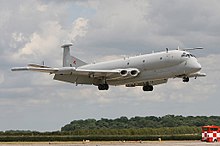
The Avro Shackleton is a British long-range maritime patrol aircraft (MPA) which was used by the Royal Air Force (RAF) and the South African Air Force (SAAF). It was developed by Avro from the Avro Lincoln bomber, which itself had been a development of the famous wartime Avro Lancaster bomber.

A maritime patrol aircraft (MPA), also known as a patrol aircraft, maritime reconnaissance aircraft, maritime surveillance aircraft, or by the older American term patrol bomber, is a fixed-wing aircraft designed to operate for long durations over water in maritime patrol roles — in particular anti-submarine warfare (ASW), anti-ship warfare (AShW), and search and rescue (SAR).

No. 206 Squadron is a Test and Evaluation Squadron of the Royal Air Force. Until 2005 it was employed in the maritime patrol role with the Nimrod MR.2 at RAF Kinloss, Moray. It was announced in December 2004 that 206 Squadron would disband on 1 April 2005, with half of its crews being redistributed to Nos. 120 and 201 Squadrons, also stationed at Kinloss. This was a part of the UK Defence Review called Delivering Security in a Changing World; the Nimrod MR.2 fleet was reduced in number from 21 to 16 as a consequence.

Royal Air Force Kinloss, or more simply RAF Kinloss, is a former Royal Air Force station located near the village of Kinloss, on the Moray Firth in the north east of Scotland, UK.
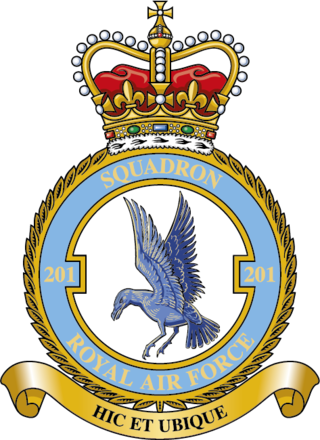
Number 201 Squadron is a squadron of the Royal Air Force. It currently operates the Boeing Poseidon MRA1 from RAF Lossiemouth, Moray.
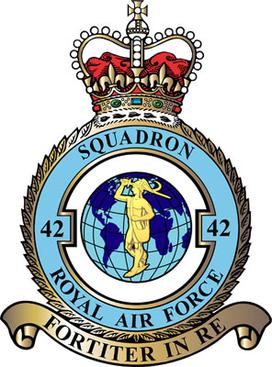
Number 42 Squadron, also known as No. 42 Squadron, is a squadron of the Royal Air Force. It reformed at RAF Lossiemouth on 21 September 2023 as the Operational Conversion Unit for both the Boeing Poseidon MRA1 and Boeing Wedgetail AEW1.

Number 120 Squadron or No. CXX Squadron is a squadron of the Royal Air Force which was established as a Royal Flying Corps unit late in World War I, disbanded a year after the end of the war, then re-established as a RAF Coastal Command squadron during World War II. Although disbanded again a month after Victory in Europe Day, during and after World War II it operated almost continuously, with maritime patrol aircraft; most recently with the Hawker Siddeley Nimrod, based at RAF Kinloss in Scotland until the type's withdrawal in March 2010. The squadron was disbanded again the following year. No. 120 Squadron stood up again in April 2018 at RAF Lossiemouth and became the first squadron to be equipped with the Boeing Poseidon MRA1 anti-submarine warfare (ASW) aircraft on 31 October 2019.

No. 220 Squadron of the Royal Air Force (RAF) was founded in 1918 and disbanded in 1963 after four separate periods of service. The squadron saw service in both the First and Second World Wars, as a maritime patrol unit, and finally as part of Britain's strategic nuclear deterrent.

On 2 September 2006, a Royal Air Force Hawker Siddeley Nimrod suffered an in-flight fire and subsequently crashed in Kandahar, Afghanistan, killing all fourteen crew members on board. The crash, which occurred during a reconnaissance flight, was the biggest single loss of life suffered by the British military since the Falklands War.

Royal Air Force St. Eval or RAF St. Eval was a Royal Air Force station for the RAF Coastal Command, southwest of Padstow in Cornwall, England, UK. St Eval's primary role was to provide anti-submarine and anti-shipping patrols off the south west coast. Aircraft from the airfield were also used for photographic reconnaissance missions, meteorological flights, convoy patrols, air-sea rescue missions and protection of the airfield from the Luftwaffe.
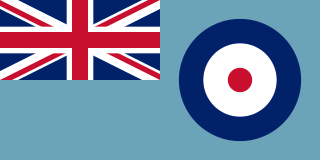
No. 18 Group of the Royal Air Force was a group active from 1918 to 1919, and from 1938 to 1996.

The BAE Systems Nimrod MRA4 was a planned maritime patrol and attack aircraft intended to replace the Hawker Siddeley Nimrod MR2. The rebuilt aircraft would have extended the operating life of the Nimrod fleet by several decades and significantly improved the aircraft by installing more efficient Rolls-Royce BR700 turbofan jet engines to almost double the flight range. The conversion of the flight deck to a digital glass cockpit would have simplified control operations and reduced crew requirements. New detection systems were to be installed, as well as additional weapons for anti-submarine warfare.

The British Aerospace Nimrod AEW3 was a proposed airborne early warning (AEW) aircraft which was to provide airborne radar cover for the air defence of the United Kingdom by the Royal Air Force (RAF). The project was designed to use the existing Nimrod airframe, in use with the RAF as a maritime patrol aircraft, combined with a new radar system and avionics package developed by Marconi Avionics.

Kinloss Barracks is a military installation located near the village of Kinloss, on the Moray Firth in the north of Scotland. Until 2012 it was a Royal Air Force (RAF) station, RAF Kinloss.
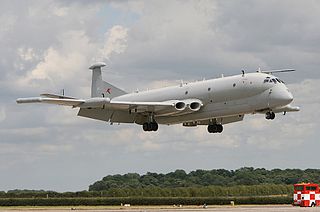
The Hawker Siddeley Nimrod R1 is a signals intelligence (reconnaissance) aircraft formerly operated by the Royal Air Force. The aircraft was a conversion of the existing Nimrod maritime patrol aircraft, with all of the electronic equipment and armament optimised for anti-submarine and anti-ship warfare, and search and rescue, replaced by equipment for the gathering of communications intelligence and electronic intelligence.

On Tuesday 16 May 1995, a Royal Air Force Nimrod R1 aircraft suffered an in-flight engine fire which led to the aircraft having to ditch in the Moray Firth. This was the first of two Nimrods to be lost in 1995; it was followed by the crash of a Nimrod MR2 in Canada in September.
At the end of the Cold War in 1989, the Royal Air Force (RAF) structure was as follows:

On 2 September 1995, a Royal Air Force Hawker Siddeley Nimrod aircraft crashed into Lake Ontario during an air display, killing all seven crew members on board. This was the second loss of an RAF Nimrod in four months, following the ditching of a Nimrod R1 in May.

On 30 April 1990, a Royal Air Force Avro Shackleton AEW Mk II aircraft, of No. 8 Squadron RAF, based at RAF Lossiemouth, crashed into a hill on the Isle of Harris whilst attempting to land at RAF Benbecula. All ten crew on board died in the crash, which included the wing commander who was in charge of No. 8 Squadron at the time. The Shackleton was the last of the fleet to be involved in a fatal accident, and the type was withdrawn from RAF service in 1991.

The 1955 RAF Shackleton aircraft disappearance occurred on 11 January 1955, when two Shackleton aircraft of No. 42 Squadron, RAF, disappeared over the sea south west of the Irish coast. The main theory put forward and accepted in some circles is that the two aircraft crashed into each other after they launched within six minutes of each other, and were en-route to the same area. Wreckage from one of the aircraft was found 11 years later, in a different location to their supposed accident point. At least one writer has commented on this being the worst of all the Shackleton losses.


